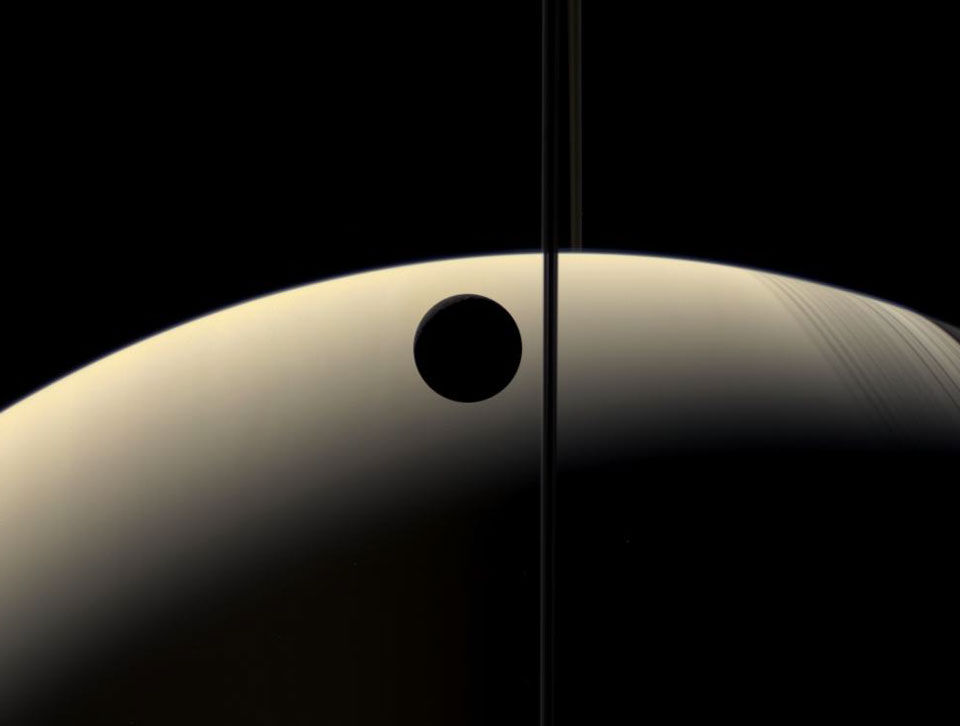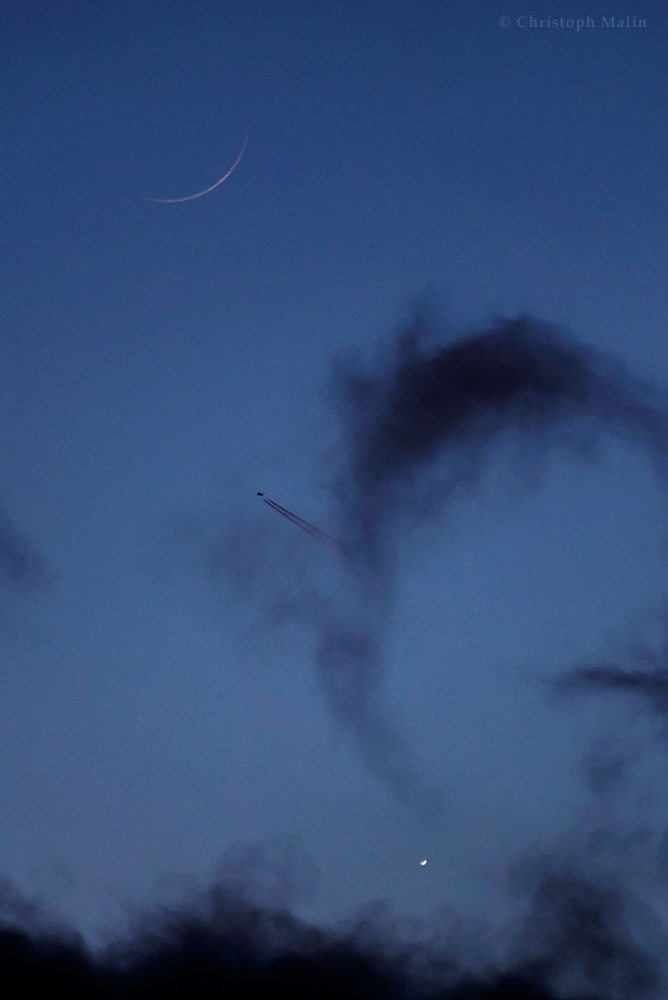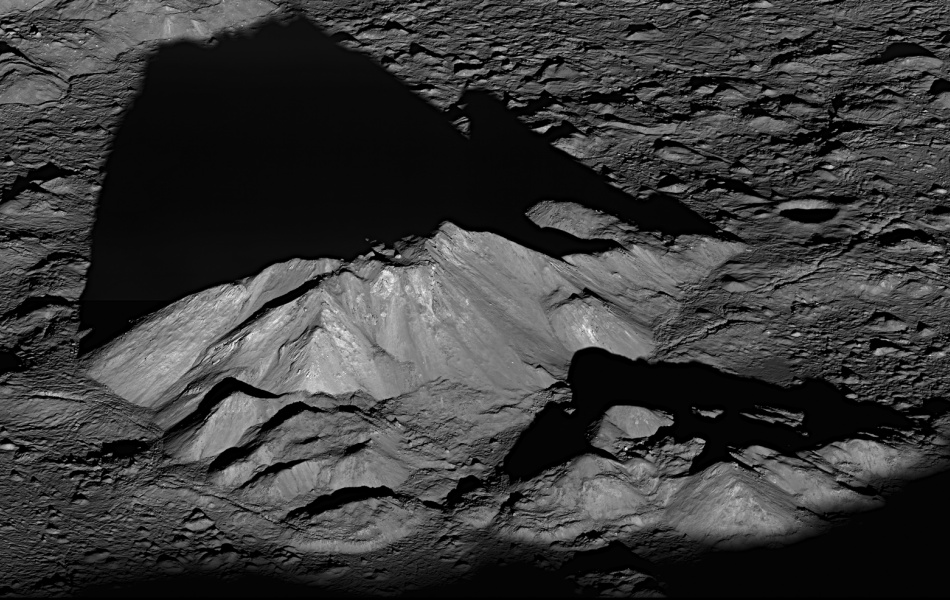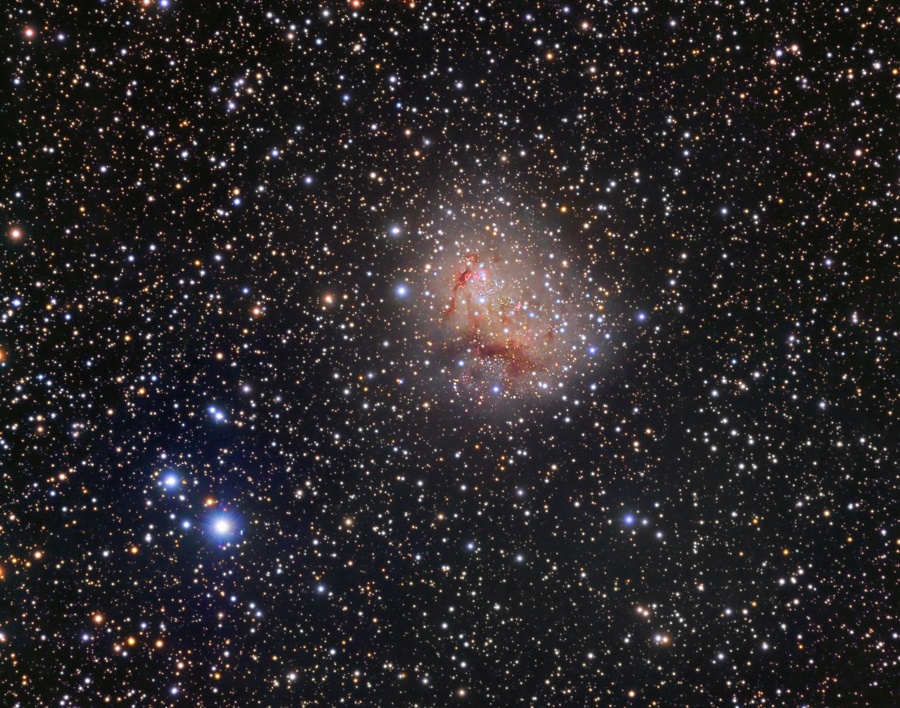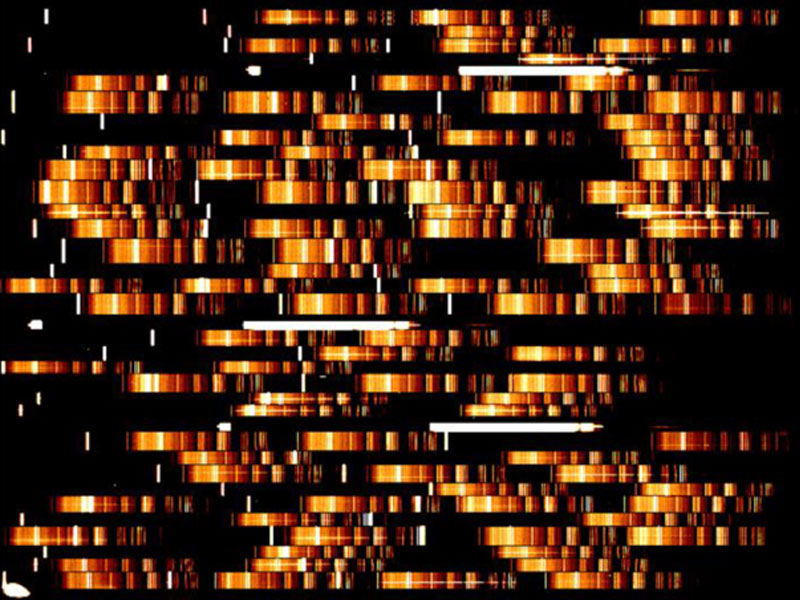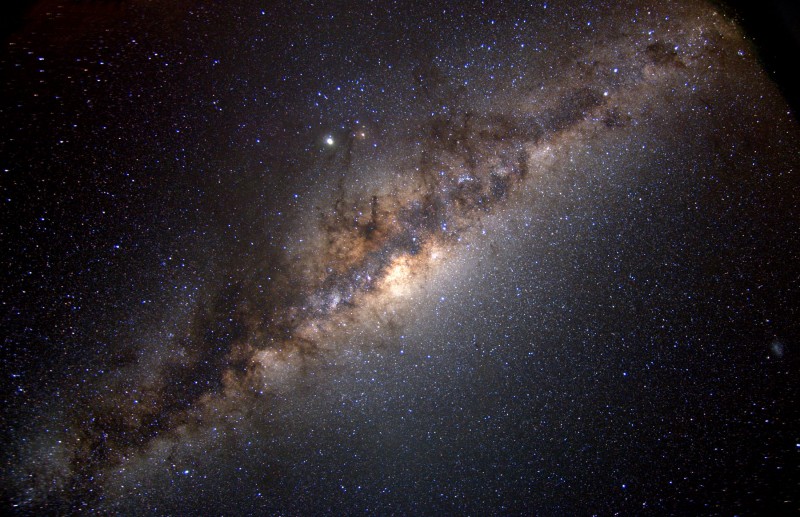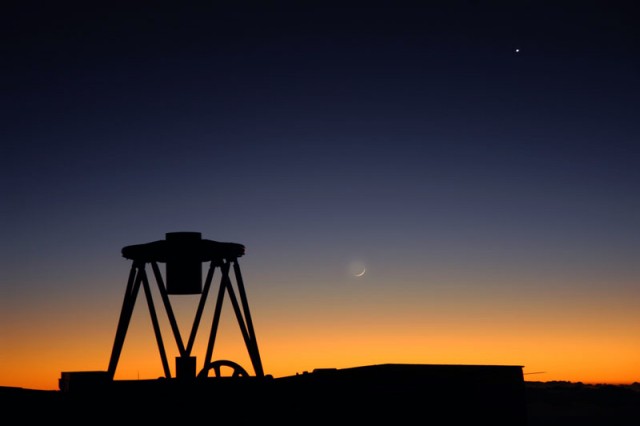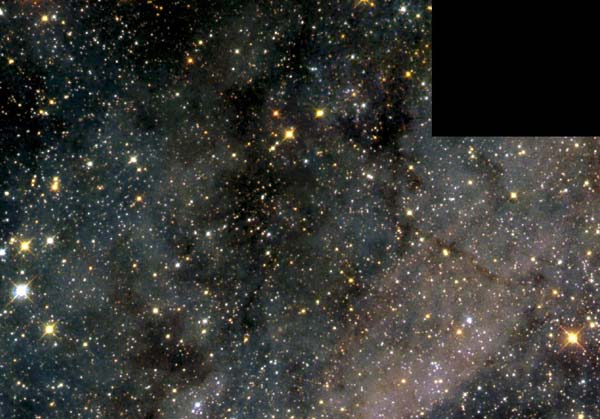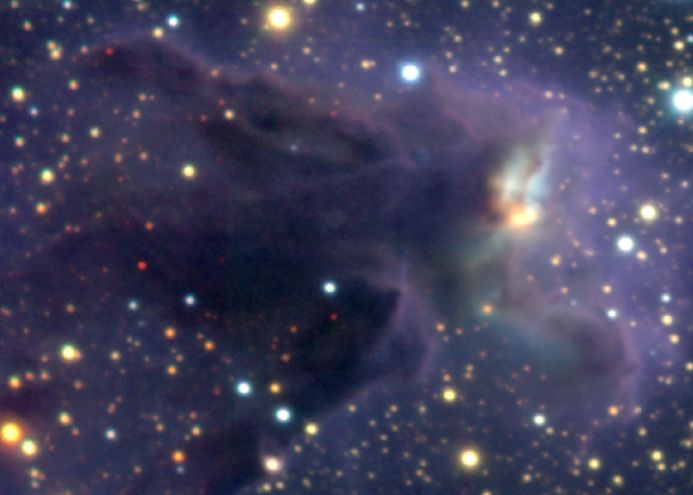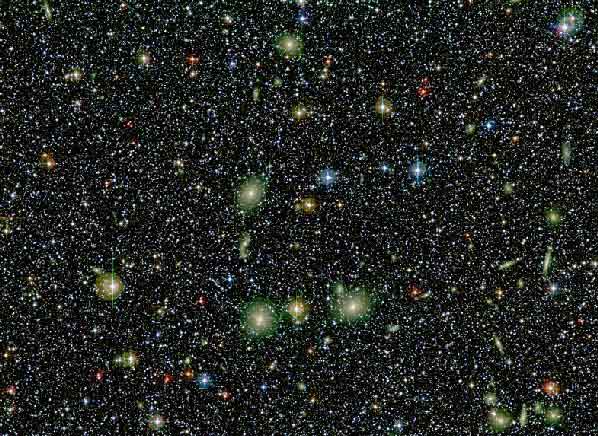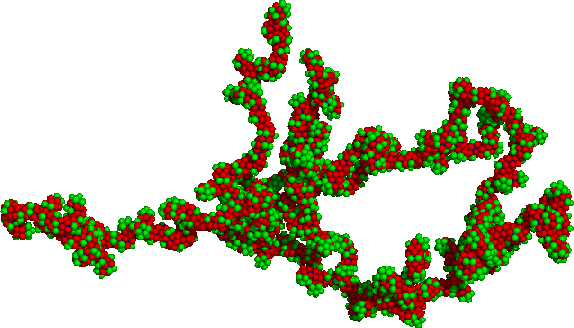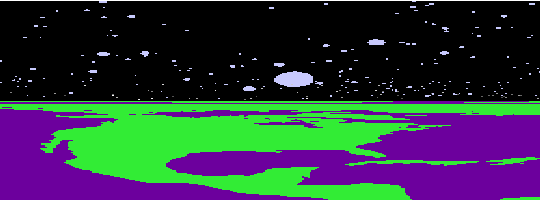| << Previous | Index | Next >> |
2015 Soft hues, partially lit orbs, a thin trace of the ring, and slight shadows highlight this understated view of the majestic surroundings of the giant planet Saturn. Looking nearly back toward the Sun, the robot Cassini spacecraft now orbiting Saturn captured crescent phases of Saturn and its moon Rhea in color a few years ago. As striking as the above image is, it is but a single frame from a 60-frame silent movie where Rhea can be seen gliding in front of its parent world. Since Cassini was nearly in the plane of Saturn's rings, the normally impressive rings are visible here only as a thin line across the image center.
2014 A crescent Venus shines along the western horizon at dusk in this clearing sky. The Earth's sister planet is smiling between the low clouds near the bottom of the frame during its January 2nd conjunction with the slender, young crescent Moon above. Of course the lovely pairing of Moon and Venus crescents could be enjoyed in the new year's skies around the the world. But the twin contrails in this scene belong to an aircraft above Appenzell, Switzerland. Soon to disappear from evening skies, Venus is heading toward its January 11th inferior conjunction and an appearance in predawn skies as planet Earth's morning star by late January. And the Moon will be young again, too.
2013 Tycho crater's central peak complex casts a long, dark shadow near local sunrise in this spectacular lunarscape. The dramatic oblique view was recorded on June 10, 2011 by the Lunar Reconnaissance Orbiter. Shown in amazing detail, boulder strewn slopes and jagged shadows appear in the highest resolution version at 1.5 meters per pixel. The rugged complex is about 15 kilometers wide, formed in uplift by the giant impact that created the well-known ray crater 100 million years ago. The summit of its central peak reaches 2 kilometers above the Tycho crater floor.
2012 Lurking behind dust and stars near the plane of our Milky Way Galaxy, IC 10 is a mere 2.3 million light-years distant. Even though its light is dimmed by intervening dust, the irregular dwarf galaxy still shows off vigorous star-forming regions that shine with a telltale reddish glow in this colorful skyscape. In fact, also a member of the Local Group of galaxies, IC 10 is the closest known starburst galaxy. Compared to other Local Group galaxies, IC 10 has a large population of newly formed stars that are massive and intrinsically very bright, including a luminous X-ray binary star system thought to contain a black hole. Located within the boundaries of the northern constellation Cassiopeia, IC 10 is about 5,000 light-years across.
2011 Many think it is just a myth. Others think it is true but its cause isn't known. Adventurers pride themselves on having seen it. It's a green flash from the Sun. The truth is the green flash does exist and its cause is well understood. Just as the setting Sun disappears completely from view, a last glimmer appears startlingly green. The effect is typically visible only from locations with a low, distant horizon, and lasts just a few seconds. A green flash is also visible for a rising Sun, but takes better timing to spot. A dramatic green flash, as well as an even more rare blue flash, was caught in the above photograph recently observed during a sunset visible from Teide Observatory at Tenerife, Cannary Islands, Spain. The Sun itself does not turn partly green or blue -- the effect is caused by layers of the Earth's atmosphere acting like a prism.
2010 What does a comet nucleus look like? Formed from the primordial stuff of the Solar System, comet nuclei were thought to resemble very dirty icebergs. But ground-based telescopes revealed only the surrounding cloud of gas and dust of active comets nearing the Sun, clearly resolving only the comet's coma, and the characteristic cometary tails. In 1986, however, the European spacecraft Giotto became one of the first group of spacecraft ever to encounter and photograph the nucleus of a comet, passing and imaging Halley's nucleus as it approached the sun. Data from Giotto's camera were used to generate this enhanced image of the potato shaped nucleus that measures roughly 15 kilometers across. Some surface features on the dark nucleus are on the right, while gas and dust flowing into Halley's coma are on the left. Every 76 years Comet Halley returns to the inner Solar System and each time the nucleus sheds about a 6-meter deep layer of its ice and rock into space. This debris shed from Halley's nucleus eventually disperses into an orbiting trail responsible for the Orionids meteor shower, in October of every year, and the Eta Aquariids meteor shower every May.
2009 In the distant universe, time appears to run slowly. Since time-dilated light appears shifted toward the red end of the spectrum (redshifted), astronomers are able to use cosmological time-slowing to help measure vast distances in the universe. Above, the light from distant galaxies has been broken up into its constituent colors (spectra), allowing astronomers to measure the redshift of known spectral lines. The novelty of the above image is that the distance to hundreds of galaxies can now be measured on a single frame using the Visible MultiObject Spectrograph operating at the Very Large Telescope array in Chile. Analyzing the space distribution of distant objects will allow insight into when and how stars, galaxies, and quasars formed, clustered, and evolved in the early universe.
2008 Climb up to 5000 meters (16,500 feet) above sea level, near Cerro Chajnantor in the northern Chilean Andes, and your night sky could encompass this cosmic vista. Recorded from that high and dry locale, the spectacular fish-eye image features the myriad stars and sprawling dust clouds of our Milky Way Galaxy. The direction toward the center of the Galaxy is near the zenith and center of the picture, but the Galactic Center itself is hidden from view, located far behind the obscuring dust. Brilliant Jupiter rules this scene just above the Milky Way's central bulge with the noticeably fainter, yellowish, giant star Antares to its right. Small and faint, near the right edge of the picture is one of the Milky Way's many satellite galaxies, the Small Magellanic Cloud.
2007 Supergiant star Gamma Cygni lies at the center of the Northern Cross, famous asterism in the constellation Cygnus the Swan. Known by the proper name Sadr, the bright star also lies at the center of this gorgeous skyscape, featuring a complex of stars, dust clouds, and glowing nebulae along the plane of our Milky Way galaxy. The field of view spans over 3 degrees (six Full Moons) on the sky and includes emission nebula IC 1318 and open star cluster NGC 6910. Left of Gamma Cyg and shaped like two glowing cosmic wings divided by a long dark dust lane, IC 1318's popular name is understandably the Butterfly Nebula. Above and left of Gamma Cyg, are the young, still tightly grouped stars of NGC 6910. Some distance estimates for Gamma Cyg place it at around 750 light-years while estimates for IC 1318 and NGC 6910 range from 2,000 to 5,000 light-years.
2006 Fading sunlight, a young crescent Moon, and brilliant Venus shared the western sky in this view of 2005's final sunset from the top of Mount Haleakala, on Maui, Hawaii. Also known as the Sacred House of the Sun, Haleakala, is Maui's dormant volcano. At 10,000 feet the summit is an ideal site for astronomical observatories, and this scene also features the silhouette of the northern hemisphere Faulkes Telescope. Of particular interest to students the Faulkes Telescope is a 2-meter diameter instrument, dedicated to astronomy education, that can be remotely operated over the internet. The project is a joint effort between the Dill Faulkes Educational Trust and the University of Hawaii Institute for Astronomy. Of course on Haleakala, "Happy New Year" would be "Hauoli Makahiki hou" (how-oh-lee ma-ka-hee-key ho).
2005 What does our Milky Way Galaxy look like from afar? Since we are stuck inside, and since opaque dust truncates our view in visible light, nobody knows for sure. Drawn above, however, is a good guess based on many different types of observations. In the Milky Way's center is a very bright core region centered on a large black hole. The Milky Way's bright central bulge is now thought to be an asymmetrical bar of relatively old and red stars. The outer regions are where the spiral arms are found, dominated in appearance by open clusters of young, bright, blue stars, by red emission nebula, and by dark dust. The spiral arms reside in a disk dominated in mass by relatively dim stars and loose gas composed mostly of hydrogen. What is not depicted is a huge spherical halo of invisible dark matter that dominates the mass of the Milky Way as well as the motions of stars away from the center.
2004 After a seven month voyage through interplanetary space, NASA's Spirit Rover has reached the surface of the Red Planet and returned the first images from its landing site in Gusev crater! The entry, descent, and landing phase of its mission - referred to by mission planners as "Six Minutes of Terror" - began Saturday night around 8:30pm PST as Spirit entered the martian atmosphere at about 12,000 miles per hour. Depicted in the above artist's illustration, the spacecraft is in the final stages of its landing sequence, swaddled in large, protective airbags and bouncing to a soft landing on Mars. The same type of airbags were used for the Mars Pathfinder landing in 1997. Updates on Spirit's status will be posted throughout the day.
2003 Stars of many types and colors are visible in this Hubble Space Telescope close-up of a starfield in the Large Magellanic Cloud (LMC). Over 10,000 stars are visible -- the brightest of which are giant stars. Were our Sun at the distance of these stars, about 170,000 light-years, it would hardly be discernable. By contrast, only a few thousand individual stars can be seen in the night sky with the unaided eye, and many of these lie within only a few hundred light-years. So typically, the light we see from nearby stars left during the age of our great-grand-parents, while light from LMC stars started its journey well before the dawn of recorded human history.
2002 The head of an interstellar gas and dust cloud is shown here in false-color, a near-infrared view recorded by astronomers hunting for stars within M16's Eagle Nebula. Made famous in a 1995 Hubble image of the 7,000 light-year distant star forming region, the pillar-shaped cloud's surface was seen to be covered with finger-like evaporating gaseous globules (EGGs). The near-infrared image penetrates the obscuring dust cloud's edges. But the cloud's core appears dark and opaque, even at these relatively long wavelengths. Still, this image, made with ESO's Antu telescope, reveals a massive, bright yellow star not directly detected in the visible light Hubble data. This very young star lights up the small bluish nebula with a dark, twisted central stripe, just above it. Below and to its right are several much fainter, less massive stars also not seen in visible light - newborn stars which lie within the Eagle's EGGs. These newborn stars may have already been collapsing, forming from material inside the nebula before the intense radiation from other, nearby, emerging hot stars eroded and sculpted the dramatic pillars and EGGs. In any event, as the dusty clouds are eroded away, stars still forming will be cutoff from their reservoir of star stuff. Further growth and even the development of planetary systems will likely be seriously affected.
2001 The first eclipse of the third millennium is coming up! A total lunar eclipse mainly visible from Europe, Asia, and Africa, will occur on January 9th as the full Moon glides through the long, but not so dark shadow of planet Earth. Why not so dark? Sunlight is actually scattered and refracted into Earth's shadow by the atmosphere, a circumstance which can help create some striking photographs of the eclipsed Moon. For example, this image is a composite of photographs taken during the July 2000 total lunar eclipse. Early and late phases of the eclipse flank a deep exposure made during totality. The feeble sunlight still shining on the lunar surface gives the Moon a dramatic dark red cast. While the July 2000 eclipse was not the first or last of any millennium, it was remarkable for being the longest eclipse for about the next 1,000 years, totality lasting an impressive one hour and 47 minutes. Totality for the January 9th eclipse will last just over one hour.
2000 Galaxies dot the sky like jewels in the direction of a mass so large it is known simply as the Great Attractor. The galaxies pictured above are part of a cluster of galaxies called ACO 3627 near the center of the Great Attractor. Previously, this cluster of galaxies, also known as the Norma Cluster, was largely unstudied because dust in the disk of our own Galaxy obscured much of its light. The Great Attractor is a diffuse mass concentration fully 250 million light-years away, but so large it pulls our own Milky Way Galaxy and millions of others galaxies towards it. Many of the galaxies in ACO 3627 are slowly heading towards collisions with each other.
1999 It is difficult to hide a galaxy behind a cluster of galaxies. The closer cluster's gravity will act like a huge lens, pulling images of the distant galaxy around the sides and greatly distorting them. This is just the case observed in the above recently released image from the VLT. The cluster CL2244-02 is composed of many yellow galaxies and is lensing the image of a blue-white background galaxy into a huge arc. Careful inspection of the image will reveal at least one other lensed background galaxy appearing in red. The foreground cluster can only create such a smooth arc if most of its mass is smoothly distributed dark matter - and therefore not concentrated in the yellow galaxies visible. Analyzing these gravitational arcs gives astronomers a method to estimate the dark matter distribution in clusters of galaxies.
1998 Our universe is a very dusty place. Dust usually shows its presence by blocking out light emitted from stars or nebulae behind it, sometimes creating the illusion of a horse's head or a sombrero hat. But nobody really knows what a typical interstellar dust grain looks like. By studying how dust absorbs, emits, and reflects light, astronomers do know that interstellar dust is much different than the cell and lint based dust found around a typical house. Interstellar dust grains are composed mostly of carbon, silicon, and oxygen and are usually less than about 1/1000 of a millimeter across. Recent work indicates that most dust grains are not spherical. The above picture shows the result of a fractal adhesion model for dust grains involving random conglomerates of spherical compounds of different properties, here artificially highlighted by different colors.
1997 The above computer animated picture depicts how a very compact star would look to a nearby observer. The star pictured is actually more compact that any known except a black hole, so it is only hypothetical. The observer is situated at the photon sphere, where photons can orbit in a circle. To help the viewer better visualize the great distortions created by gravity, a map of the Earth was projected onto the star, and a map of the familiar night sky was projected above. From here one can either look down and see several duplicate images of the entire surface of the star, look up and see several duplicate images of the entire night sky, or look along the photon sphere and see the back of one's own head.
1996
| << Previous | Index | Next >> |
